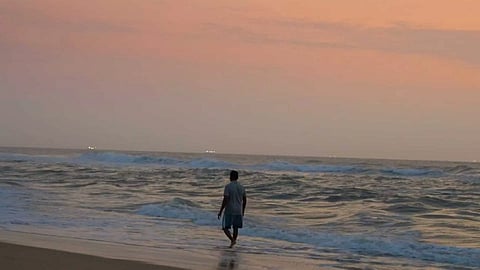

CHENNAI: Beaches are more than just a touristy place for people in Chennai. It's a part of their lives. On one hand, it is a great hang out spot when we are with friends and family; on the other hand, people get lost in the serenity of the waves. It is absolutely scorching in Chennai now because of the heat waves. Shifting the focus on how climate change and global warming can affect the water bodies to a large extent, artist Parvathi Nayar, an aquaphile, has curated a one-of-its-kind exhibition in Dakshinachitra, titled The Living Ocean.
“I was invited to curate a permanent hybrid exhibition at the heritage museum that revolves around an idea that is close to my heart. A lot of my artwork focuses on water. This is an opportunity for me to talk about something I care about,” starts Parvathi. An exhibition showcasing different elements like infographics, paintings, installations and film screening, among others, is called a hybrid exhibition.
“Many of us don’t understand the aftermath of global warming and climate change. After talking to climate experts, graphic designer VS Sindhura and I created interactive infographics on ocean stratification, acidification and threatened marine species, leading to knowledge exchange. Lest They Disappear displays endangered species and how coastal areas and wetlands are the habitat for them. Destroying these places can result in the destruction of a certain biosphere for these birds. One major advantage of art is that it can be addressed without being too preachy,” says the artist.
Three installations are created by the Hashtag#Collective namely Hope Is A Thing With Feathers, where the birds vanish as people walk around them. This features images of birds photographed by Chennai-based photographer Rajiv Kalmadi. Reef exhibits the threat on coral reefs due to rising ocean temperatures. Another installation, Ocean Forest, is about the significance of the Mangrove forest. To give an immersive experience for the visitors, there is an ocean room, where sound designer Madhu Vishwanathan has installed the chirps of birds and the tranquil sound of waves. The Data String corner tests people’s awareness about the ocean.
Apart from these, there is a film screening by Parvathi. Titled Seaspeaker, the film is about Urur Olcott Kuppam fisherman S Palayam. “For the past five years, he visited the beach everyday, to record data about the weather and waves. He noticed the conditions are changing because of climate change. The narrative is brought to life by Kalaimamani Muthuchandran Rao, a sixth-generation shadow puppeteer from Tamil Nadu, and his team,” shares Parvathi, who has spent more than a decade of her life in Chennai. She also adds that The Living Ocean displays historical, cultural and artistic perspectives of water bodies.
There is a sculpture of Lord Varuna, the Indian god of rain and ocean. Of Fish and Water features the reprints of Mary Symonds's watercolours, about the historical insight into the fish that were seen here in colonial times.
Symonds was an Englishwoman, who travelled to Chennai and painted the fish she saw in Kovalam. Ghost in the Shell are upcycled ghost crabs by P Madhukar.
One of the important attractions in the hybrid exhibition is the Ocean’s Breath. It is a hanging installation of metal diatoms that are derived from the drawings done by Parvathi. This is about diatoms that exist in the waters and give us about 40 % of the oxygen we breathe. She collaborated with Regi Varghese and his team from Forms And Gears for the metalwork. “We were guided by the artistic vision of Parvathi. It took four months for us to complete the metal exhibit after trying out different types of metals. There are 10 such fixtures in a metre in spherical size. We are planning to expand it on a much bigger scale and install these in public places," Regi Varghese explains.
Talking about the collaboration, an elated Parvathi says, “I am always fascinated by how science and art can come together. Art is a great tool to transmit scientific knowledge to people.” She wants the visitors to spend time and observe the elements exhibited. “A deeper understanding of the ocean and the disastrous effects of human activities should be the takeaway,” she hopes.
“Art gives a visual form and a chance for people to relate to an idea at different levels. The scientific language may be hard for some people, but the visual language can draw people in and give a larger picture,” concludes the multidisciplinary artist.
The Living Ocean, a hybrid permanent exhibition will be inaugurated at the Moplah House in DakshinaChitra Museum on April 13 at 3 pm.